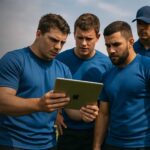Almost half of all intercollegiate athletes will experience an injury during their college years. At such a young age, an injury could be one of the most physically and emotionally disturbing occurrences in an athlete’s development, making it vital for coaches and performance experts to understand the causes behind the injuries. Studies have shown that stress is one of the highest contributors for student-athletes, with a third of all males and half of all female athletes experiencing symptoms of anxiety and depression. The biggest cause of stress for college athletes is an imbalance, between decreasing sleep and increasing time commitments to sport and academics. It is recommended to support college athletes, that coaches monitor both the cognitive and physical wellbeing of their squads, to intervene during times of high stress and reduce the likelihood of injury.
INTRODUCTION
According to the National Collegiate Athletic Association (NCAA) intercollegiate athletics embodies demanding culture. Student-athletes’ wins and losses are seen by many and often criticized publicly (e.g. 90,000+ people attended the Rose Bowl). The NCAA has maintained an injury surveillance system (ISS) for intercollegiate athletics since 1982. The primary goal of the ISS is to collect injury and exposure data from a representative sample of NCAA institutions in a variety of sports to form evidence-based decision making with regard to health and safety issues (Agel & Marshall, 2007). In this report, we consider the unique demands placed on student athletes and the importance of monitoring in the collegiate environment.
NCAA AND OVERUSE INJURIES
An injury may be one of the most physically and emotionally disturbing events experienced by a collegiate athlete. Approximately 40-50% of student-athletes sustain an injury during NCAA sports each year (Li, Moreland, Peek-Asa et al., 2017). Overuse injuries are a category of sport-related injuries that result from cumulative trauma or repetitive use and stress. Overuse injuries are typically associated with lower-contact sports that involve repetitive movements and are responsible for a substantial amount of time loss for athletes across sports. Overuse injuries can carry additional stress for student-athletes due to possible loss of scholarship funding and significantly lowered academic performance in addition to time loss from their sport (Freedman et al. 1998).
PSYCHOLOGICAL WELLBEING AND INJURY
Stress-injury models suggest that athletes experience more physical injuries during times of high stress. Notably, from a study examining 4 men’s and 5 women’s sports from 2 NCAA Division 1 universities, anxiety and depressive symptoms are reported by 31% of male and 48% of female athletes (Li, Moreland, Peek-Asa et al., 2017). The NCAA Sport Science Institute has called for more research studies focused on improving collegiate athletes’ mental health and overall well-being.Athletes experiencing anxiety or depressive symptoms could face an increased vulnerability to injuries because of decreased concentration and attention levels during practices and games and/or reduced or insufficient apprehension of threatening stimuli (Li, Moreland, Peek-Asa et al., 2017).
Student-athlete stress can come from a variety of sources on and off the field (e.g. physical, travel, time, academic or social demands) (Metzler, 2002). Mann et al., (2016) divided a Student-Athlete’s stress into 3 categories: High Physical Stress (HPS), High Academic Stress (HAS), Low Academic Stress (LAS). The study found that injury rates during weeks of HAS were almost twice as high as during weeks of LAS. The authors urged coaches to be aware of both physical and academic stress as they both play a significant role in injury risk.
STUDENT-ATHLETES AND SLEEP
A study by the PAC-12 in 2015 found that ‘sleep’ and ‘time’ were the top two sources of stress for student-athletes. Time spent in sport impacted their time available to study and also increased fatigue levels. Increased fatigue also impacted their perceived ability to study. In continuing with this vicious circle, additional anxiety about not being able to study would leave athletes with more sleepless nights, further hindering both academic athletic performance. In fact, the report stated that “Sleep is the number one thing their athletic time commitments prevent them from doing”.
FATIGUE AND INJURY
Fatigue can also influence risk of injury on the field. For example, central fatigue (from training load etc.) can result in altered suboptimal biomechanical patterns. Maclean & Samorevoz (2009) examined the impact of fatigue on 20 female NCAA athletes. The results showed that central fatigue was related to altered landing strategies and results in decreased knee flexion on landing. Decreased knee flexion at initial contact increases the ground reaction forces transmitted through the knee joint increasing the risk of injury to the knee joint.
CONCLUSION
As a coach, a healthy training/study time balance is desirable. Understandably, this will ebb and flow throughout the course of the season/academic year as competition or examinations take priority. Monitoring important parameters (sleep, stress and anxiety) is key to checking if an adequate balance has been achieved. A simple daily wellbeing questionnaire can allow coaches to make informed decisions and hopefully negate the risk of injury. In turn, this will allow student-athletes to attain their potential on the field and in the classroom.
Written by Kitman Labs Head of Research, Susan Giblin, PhD.
References
- Humphrey, J. H., Yow, D. A. & Bowden, W. W. (2000). Stress in college athletics: Causes, consequences, coping. Binghamton, NY: The Haworth Half-Court Press.
- Mann J.B., Bryant K.R., Johnstone B., Ivey P.A., Sayers S.P. 2016 Effect of Physical and Academic Stress on Illness and Injury in Division 1 College Football Players. J Strength Cond Res. 2016 Jan;30(1):20-5.
- Mclean, S. G., & Samorezov, J. E. (2009). Fatigue-induced ACL injury risk stems from a degradation in central control. Medicine and science in sports and exercise, 41(8), 1661-1672.
- Metzler, J. (2002). Applying motivational principles to individual athletes. In J. M. Silva & D. E. Stevens (Eds.), Psychological foundations of sport (pp. 80-106). Boston:Allyn and Bacon.
- Li, H., Moreland, J. J., Peek-Asa, C., & Yang, J. (2017). Preseason anxiety and depressive symptoms and prospective injury risk in collegiate athletes. The American Journal of Sports Medicine, 0363546517702847.
- PAC-12 (2015), Student-Athlete Time Demands. https://www.cbssports.com/images/Pac-12-Student-Athlete-Time-Demands-Obtained-by-CBS-Sports.pdf
- Papanikolaou, Z., Nikolaidis, D., Patsiaouras, A., & Alexopoulos, P. (2003). The freshman experience: High stress-low grades. Athletic Insight: The On-line Journal of Sport Psychology, 5.




